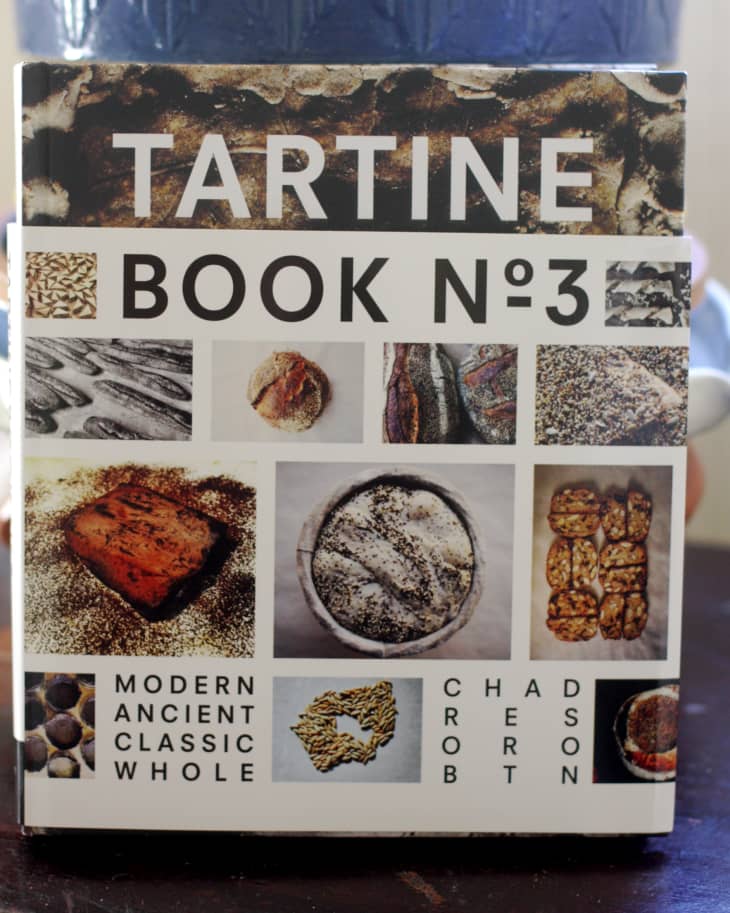Tartine Book No. 3 by Chad Robertson
The long-awaited, much anticipated Tartine Book No. 3 is here at last! Are you already a fan of the two previous Tartine books and have been waiting patiently for this latest installment? If so, you will not be disappointed. Or maybe you’ve never heard of Chad Robertson or his San Francisco based Tartine Bakery or his previous cookbooks but are interested in making your own bread using ancient and whole grains? Then dive in: this book is a game-changer.
Quick Facts
• Who wrote it: Chad Robertson
• Who published it: Chronicle Books
• Number of recipes: 85
• Recipes for right now: From the bread section: Buckwheat with Toasted Groats and Crème Fraîche; Emmer/Einkorn; Wheat-Rye-Caraway-Coriander Seeded Bread; Sprouted Emmer with Maple and Beer; René’s Rye; Oat Porridge; Kamut Crispbreads. From the pastry section: Buckwheat-Hazelnut Sablés; Salted Chocolate Rye Cookies; Apple-Walnut Tea Cake.
• Other highlights: First, it’s important to emphasize that this is not a gluten-free or 100% whole grain book. In his introduction, author Chad Robertson explains that his primary motive in working with whole and ancient grains is for what they can offer in flavor and texture and creative possibilities. “Most of the breads in this book are made with blends of whole-grain, high-extraction, and sifted (much of the bran and germ removed) flours” he explains in Whole Grain Primer that opens the book. This Primer is an excellent resource for understanding the many flours and grains available to today’s baker. Here you will find notes on several kinds of wheats (emmer, einkorn, kamut, semolina, etc) as well as other grains and seeds such as buckwheat, millet, oats, and amaranth.
The book then turns to an extensive 12 page chapter on the master method for making the Tartine loaf. While not quite as detailed as the master recipe in The Tartine Bread Book it does walk us through the basic step by step process, from creating the starter all the way through the baking of the loaf. The subsequent bread chapters then offer specific recipes for many delicious and intriguing breads, from a simple White-Wheat Blend to breads that use ancient grains like Spelt-Wheat, to seeded breads such as Sesame-Wheat, to sprouted grains (Sprouted Quinoa-Kamut, Smoked Sprouted Rye.)
I was especially taken with the Rene’s-Style Pan Loaves chapter which is Chad’s take on the dense Danish-style rye breads and the Porridge Bread chapter which uses rye, farro, and oat porridges in the doughs. But the most fascinating and playful chapter is the one on Crispbreads where bread doughs are stretched wafer thin and baked until they are crisp and cracker-like. The Kamut Crispbreads, which sandwich herb leaves, edible flowers, and thinly shaved vegetables between two laters of dough, are especially beautiful (pictured above).
We could stop there and this book would already be a revelation. But the final chapter on Pastry really pushes Tartine Book No. 3 into the genius realm. Sure, we can handle hearty whole grains and the like in our breads, but what about in cookies, gougères, tea cakes, scones, and cakes? What about a Buckwheat-Apple Tart or a Cherry Galette made with kamut flour and creme fraîche? Or a Flammenkuchen made with spelt puff pastry dough? Excuse me, please, while I faint!
Above and beyond the recipes and good solid information on somewhat obscure ingredients, Tartine Book No. 3 is also a record of Chad’s two year exploration into ancient and so-called alternative grains. Scattered throughout the book are photo-heavy interludes on his journeys to Denmark, Sweden, Germany and Austria, France, and Mexico. He also introduces identity-preserved grains, a somewhat new food movement which is seeks to identify, preserve, and properly mill the many hundreds of wheat and grain varieties that are on the brink of being lost (this article by Danielle Tsi is a good place to start for more information).
You will find plenty of photos to illustrate each bread and pastry, as well as many follow-along shots. There’s also a basic index. The book is hardcover with a glossy, colorful half-slip cover and has a good sturdy sewn binding.
• Who would enjoy this book? All bakers, professional and home-based, will want to check this out. The Tartine method of creating and building a starter is somewhat involved and happens over time, so people who are into process and experimentation are especially suited for this book.
Find the book at your local library, independent bookstore, or Amazon: Tartine Book No. 3 by Chad Robertson
• Visit the author’s website: Tartine Bakery
Apartment Therapy Media makes every effort to test and review products fairly and transparently. The views expressed in this review are the personal views of the reviewer and this particular product review was not sponsored or paid for in any way by the manufacturer or an agent working on their behalf. However, the manufacturer did give us the product for testing and review purposes.
